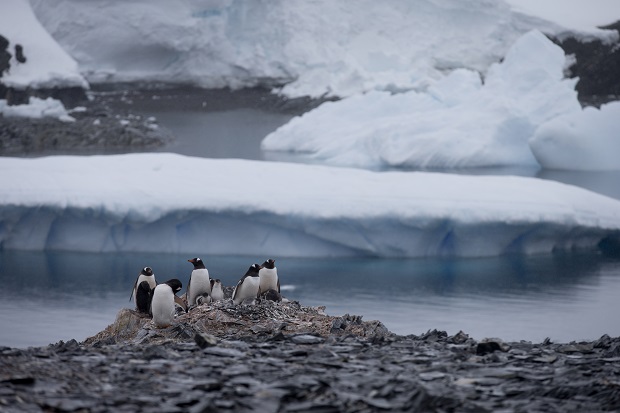
In this Jan. 22, 2015 photo, Gentoo penguins stand on rocks near the Chilean station Bernardo O’Higgins, Antarctica. Here on the Antarctic peninsula, where the continent is warming the fastest because the land sticks out in the warmer ocean, 49 billion tons of ice (nearly 45 billion metric tons), is lost a year according to NASA. AP
CAPE LEGOUPIL, Antarctica — From the ground of this extreme northern part of Antarctica, a spectacular white and blinding ice seemingly extends forever. What can’t be seen is the battle raging below to reshape Earth.
Water is eating away at the Antarctic ice, melting it where it hits the oceans. As the ice sheets slowly thaw, water pours into the sea, 130 billion tons of ice (118 billion metric tons) per year for the past decade, according to NASA satellite calculations. That’s enough ice melt to fill more than 1.3 million Olympic swimming pools. And the melting is accelerating.
In this Jan. 22, 2015 photo, a zodiac carrying a team of international scientists heads to Chile’s station Bernardo O’Higgins, Antarctica. Water is eating away at the Antarctic ice, melting it where it hits the oceans. As the ice sheets slowly thaw, water pours into the sea, 130 billion tons of ice (118 billion metric tons) per year for the past decade, according to NASA satellite calculations. AP
In the worst case scenario, Antarctica’s melt could push sea levels up 10 feet (3.3 meters) worldwide in a century or two, recurving heavily populated coastlines.
At its current rate, the rise from Antarctica would only lift the world’s oceans a barely noticeable one-third of a millimeter a year.
But if all the West Antarctic ice sheet that’s connected to water melts unstoppably, as several experts predict, there won’t be time to prepare. Scientists estimate it will take from 200 to 1,000 years to melt enough ice to raise seas by 10 feet, maybe only 100 years in a worst-case scenario.
For a dozen days in January, in the middle of the chilly Antarctic summer, The Associated Press followed scientists from different fields searching for alien-like creatures, hints of pollution trapped in ancient ice, leftovers from the Big Bang, biological quirks that potentially could lead to better medical treatments, and perhaps most of all, signs of unstoppable melting.
In this Jan. 21, 2015 photo, scuba diver Luis Torres tests the water near the Chilean scientific station Escudero in Villa Las Estrellas on King George Island, part of the South Shetland Islands archipelago in Antarctica. For a dozen days in January, in the middle of the chilly Antarctic summer, The Associated Press followed scientists from different fields searching for alien-like creatures, hints of pollution trapped in pristine ancient ice, leftovers from the Big Bang, biological quirks that potentially could lead to better medical treatments, and perhaps most of all, signs of unstoppable melting. AP
A zodiac boat carried a team of international scientists to Chile’s station Bernardo O’Higgins, and a group of penguins stood on a rock near the mission. Scientists collected samples on Deception Island, and elsewhere in Antarctica during the visit.
Here’s a look at some of the images from the trip: